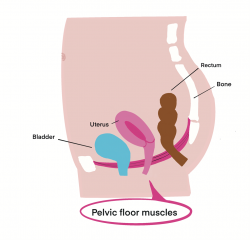
Postpartum and during menopause there is a lot that can change "down there" which can impact our ability to run. These changes commonly include urinary incontinence, prolapse/feeling of heaviness, and pelvic pain.
The good news: Common does not equal normal
Despite being common these changes should not be passed off as the "new normal" and ignored. We would never ignore a soccer related knee injury because "they are common." Similarly, you should not ignore incontinence, pelvic pain or heaviness just because they are more common during/after menopause or post-partum.
More good news: There is treatment options for your symptoms
There are many things a physiotherapist trained in pelvic floor therapy can do to help improve these symptoms and get you back to running.
 I've heard of the "Pelvic Floor" - What is it?
I've heard of the "Pelvic Floor" - What is it?
Your pelvic floor is a series of muscle that look similar to a hammock in your pelvis, it's role is to:
- Support your organs against gravity and intra-abdominal pressure (i.e. coughing)
- Control the opening of your urethra (urinary tract), rectum (bowel tract) and vagina
- Assist with sexual function
- Provide stability to your hip
- Promote circulation
Due to a variety of reasons, there can be changes to the pelvic floor and its function following child birth and during menopause. These can contribute to some of the discomfort or symptoms experienced while running.
Why are these symptoms made worst by running?
When you run:
- Your intra-abdominal pressure increases which places more pressure on your pelvic floor
- The impact of the steps can exert a lot of forces on the pelvic floor
These can all lead to dysfunction of the pelvic floor and result in symptoms!
The Quick Facts: Postpartum
Running for some women can safely begin 3-6 months postpartum, however, everyone and every pregnancy is different.
A referral should be made to a pelvic health Physiotherapist if any of the following are felt during running:
- Heaviness/dragging in the pelvic area
- Leaking urine or inability to control bowel movements
- Pendular abdomen or noticeable gap along the midline of your abdominal wall
- Pelvic or lower back pain
Prior to running postpartum, the following should be assessed: pelvic health, load impact management and strength.
Based on differences between women (e.g., weight, fitness, breathing, psychological status, DRA, breast support etc.), no one running protocol works for everyone and each program should be created on a person specific basis.
The Quick Facts: During Menopause or Postmenopause
- During menopause there are many changes to the pelvic area due to a variety of events occurring currently, such as hormonal changes, ageing or other underlying factors
- Urinary incontinence is the most frequent lower urinary tract symptom after menopause
- The prevalence of urinary incontinence increases with age, and in women 60 and older can range from 38% to 55%
- Menopause related decline in muscle mass can be addressed by staying active during menopause and postmenopause
- A tailored therapy plan should be created for women experiencing changes during menopause, including but not limited to pelvic pain, urinary incontinence and sensation of heaviness
Sound like you or someone you know?
Book your initial pelvic physio assessment today, and learn how to get back to running and moving leak and symptom free.
